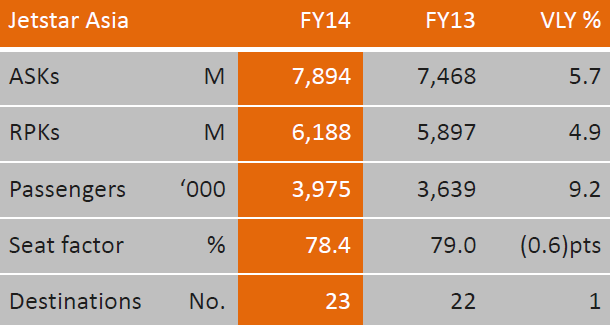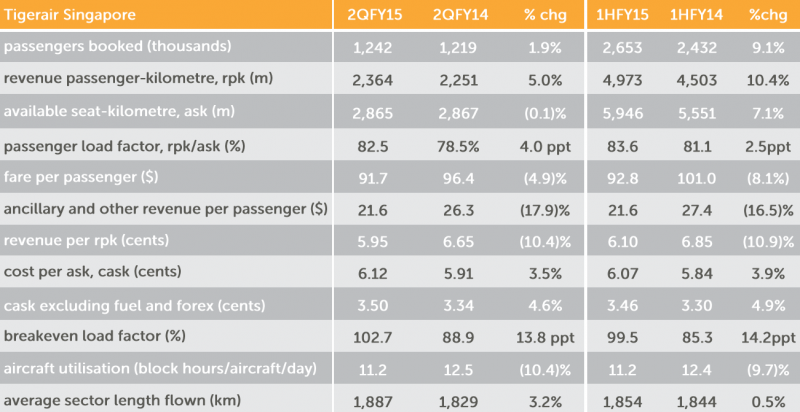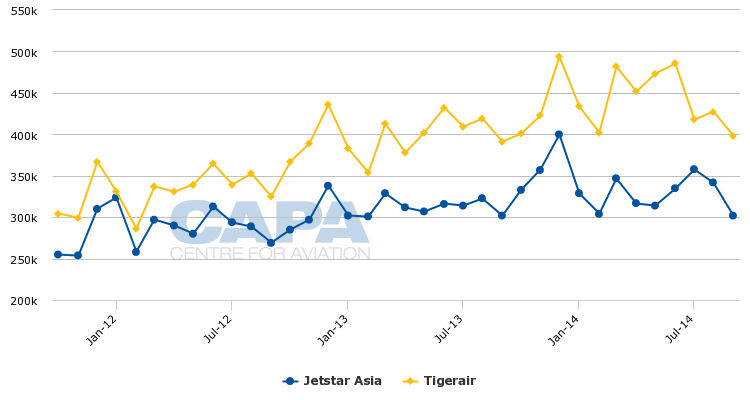Singapore short-haul LCC market remains challenging despite adjustments at Jetstar Asia and Tigerair
Overcapacity continues to impact Singapore's LCC sector, pressuring yields and resulting in unsustainable losses. But the market could start to see improvements in 2015 driven by capacity adjustments and increased reliance on partnerships.
Singapore's two short-haul low-cost carriers, Jetstar Asia and Tigerair, have both been unprofitable since early 2013 as the market failed to absorb a surge in capacity. But Tigerair has started to reduce capacity in recent months while Jetstar has modestly increased capacity without increasing its fleet.
Both LCCs meanwhile are expanding transit traffic and partnerships. By relying less on Singapore's relatively limited local market, Jetstar Asia and Tigerair Singapore should be able to eventually improve yields to a sustainable level.
Rapid LCC growth in Singapore has impacted the bottom line
LCCs have driven most of Singapore's traffic growth over the last decade, pushing up the LCC penetration rate from virtually zero in 2003 to over 30% in 2013. Jetstar Asia and Tigerair, both of which launched services in 2004, have accounted for about 30% of Changi's passenger growth over the last 10 years. In 2013 Jetstar Asia and Tigerair accounted for over 40% of total passenger growth in Singapore as the pair added over one million passengers compared to 2012.
But the rapid expansion in 2013 came at the expense of yields and profitability. Tigerair Singapore has been unprofitable for five consecutive quarters, spanning 1-Jul-2013 to 30-Sep-2014. Yields have dropped steadily, including by 10% in the most recent quarter.
Jetstar Asia also has been unprofitable over the same 15-month period. Jetstar Asia reported losses of AUD40 million (USD37 million) for the year ending 30-Jun-2014 compared to a small profit in the year ending 30-Jun-2013. Tigerair Singapore incurred operating losses totalling SGD73 million (USD58 million) in the same 12 month period compared to operating profits of SGD59 million (USD48 million) the prior year.
Tigerair Singapore posted another large loss in fiscal 2Q
Tigerair Singapore in mid Oct-2014 reported operating losses of another SGD31 million (USD25 million) in the three months ending 30-Sep-2014 (2QFY2015). Losses increased by 73% compared to the three months ending 30-Sep-2013 as revenues declined by 5% and average yield by 10%.
Tigerair Singapore financial highlights: 2QFY2015 vs 2QFY2014 and 1HFY2015 vs 1HFY2014
The further drop in yields at Tigerair Singapore is discouraging given that capacity started to flatten out during the most recent quarter, ending a period of very rapid expansion. This indicates the capacity added in prior quarters has still not been absorbed and the Singapore short-haul market continues to suffer from overcapacity.
Jetstar Asia does not report quarterly financial figures but the LCC remained in the red in the quarter ending 30-Sep-2014 as market conditions have not improved sufficiently. Jetstar Asia has noticed an uptick in yields on some routes where capacity has been rationalised but it believes more adjustments are needed for the market to fully recover.
"I'm a firm believer we will see lots of capacity reductions," Jetstar Asia CEO Bara Pasupathi said during a panel discussion at the CAPA Asia Aviation Summit and LCC Congress, which was held on 13-Oct-2014 in Singapore. "The yields in the Singapore market are not covering cost. If you have a situation yield is not covering cost you need to make the most prudent decision. You need to right size capacity to markets and push down costs as much as you can."
In speaking to CAPA TV after the panel discussion, Mr Pasupathi added: "We believe the next 18 to 24 month will be a challenging time."
Jetstar Asia CEO Bara Pasupathi discusses the challenges facing Singapore's LCC market including the losses incurred over the last year, the recent growth in codeshare/interline traffic and the eventual transition of the Jetstar Asia fleet to the A320neo
Jetstar Asia suspended fleet expansion in FY2014 but still grew capacity slightly
Mr Pasupathi pointed out that Jetstar Asia was the first LCC in Singapore to respond to the challenging market conditions by suspending growth. The carrier initially decided to halt expansion of its fleet in Aug-2013. It was not until several months later that Tigerair Singapore finally made a similar decision.
Jetstar Asia was still able to grow ASKs by 6% and seats by 11% in the year ending Jun-2014 (FY2014). But this was achieved by increasing average utilisation of the A320 fleet, which has remained at the 18 aircraft level, by 8%.
Jetstar Asia's passenger numbers were up 9% in FY2014 to 4 million. Jetstar Asia does not report yields figures but, as is evident from its profit figure, yields dropped as competition intensified.
Jetstar Asia operating highlights: FY2014 vs FY2013
Tigerair Singapore in comparison grew ASKs by 23% in 12 months ending 30-Jun-2014. This capacity was not absorbed as both load factors and yields dropped. RPKs and passenger numbers were both up 15% at Tigerair Singapore in the 12 months ending 30-Jun-2014.
See related report: Singapore LCCs: growth slows and penetration rate falls as Jetstar Asia & Tigerair incur losses
In the year ending 30-Jun-2014, Tigerair Singapore transported 5.27 million passengers while Jetstar Asia carried 3.98 million. Tigerair Singapore accounted for 10% of total passenger throughput at Changi during this period while Jetstar Asia accounted for 7%. (Note: Tigerair's fiscal year ends in March while Jetstar's fiscal year ends in June but figures below have been adjusted to show like for like comparisons.)
Key operating and financial statistics (in SGD) for Jetstar Asia and Tigerair Singapore: 12 months ending 30-Jun-2014 compared to 12 months ending 30-Jun-2013
| 2014
result |
2013 result |
2014 pax |
2013
pax |
2014
RPKs |
2013 RPKs |
2014 ASKs |
2013 ASKs |
2014 LF |
2013 LF |
|
| Tigerair Singapore | 73m loss | 59m profit | 5.27m | 4.57m | 9.68bn | 8.43bn | 12.34bn | 10.04bn | 78% | 84% |
| Jetstar Asia* | 35m loss | 3m profit | 3.98m | 3.64m | 6.12bn | 5.90bn | 7.89bn | 7.47bn | 78% | 79% |
The Jetstar Asia figures include Valuair but exclude Australia-based Jetstar Airways. Jetstar Airways currently serves Singapore with 12 weekly flights, including five A330 frequencies from Melbourne and seven weekly A320 frequencies from Bali. Vietnamese affiliate Jetstar Pacific also now serves Singapore, having launched one daily flight from Ho Chi Minh in late Oct-2014. Valuair was acquired by Jetstar Asia in 2005 but continued to operate flights in the Singapore-Indonesia market until 26-Oct-2014, when all Valuair-operated flights were finally taken over by Jetstar Asia.
The Tigerair figures exclude Tigerair Philippines, Tigerair Mandala and Tigerair Taiwan. Tigerair Philippines stopped serving Singapore after it was sold to Cebu Pacific in Mar-2014 while Tigerair Mandala suspended operations in Jul-2014. Tigerair Taiwan launched one daily flight to Singapore in late Sep-2014.
Tigerair halts growth but still struggles
Tigerair Singapore stopped expanding in mid-2014 as it embarked on a turnaround effort. The carrier's ASKs were flat in the three months ending 30-Sep-2014 (2QFY2015). RPKs were up 5% as load factor improved but this was more than offset by the 10% reduction in yields, which was driven by a 5% drop in average fares and 18% reduction in ancillary revenue per passenger.
Unit costs also increased 4% as average aircraft utilisation rates dropped by 10%. While grounding the 14 aircraft which were returned from its terminated joint ventures in the Philippines and Indonesia was the sensible move it decreased utilisation rates and increased costs at the remaining Singapore operation to the point that the break-even load factor was above 100%.
Tigerair Singapore operating highlights: 2QFY2015 vs 2QFY2014 and 1HFY2015 vs 1HFY2014
Tigerair Singapore's bloated costs and fleet inefficiencies should be resolved over the next few months as Tigerair has now been able to sublease 14 aircraft, including 12 A320s to IndiGo and two A320s to Tigerair Taiwan. These aircraft will be moved off the Tigerair Singapore books over the next few months in stages, allowing Tigerair Singapore to reduce its fleet to a more manageable 25 aircraft (23 A320s and two A319s).
One or two more subleases are still possible as Tigerair executives have said that the carrier's current schedule only requires 23 to 24 aircraft. Ideally Tigerair Singapore would find new homes or return its two A319s, which have been grounded but are now slated to return to the fleet once all the subleases are implemented.
Jetstar Asia capacity continues to increase slightly
Jetstar Asia capacity has continued to grow capacity in recent months while still keeping its fleet flat at 18 A320s. ASKs were up 13% in the quarter ending 30-Sep-2014 (Jetstar's 1QFY2015).
The growth has enabled Jetstar Asia to close the gap slightly with Tigerair Singapore, which had similar capacity levels to Jetstar Asia back in early 2012 before Tigerair started pursuing much faster expansion.
Tigerair Singapore and Jetstar Asia monthly ASKs: Oct-2011 to Sep-2014
Jetstar Asia RPKs were also up 13% in 1QFY2015 while passenger numbers were up 7% to 1 million. Tigerair Singapore passenger numbers were up only 2% during the same three month period (2QFY2015 based on the Tigerair fiscal year) to 1.24 million.
As a result Tigerair Singapore is still about 25% larger than Jetstar Asia. Tigerair Singapore and Jetstar Asia had similar passenger numbers in Jan-2012 but Tigerair Singapore subsequently pulled away as it pursued rapid, and what turned out to be overambitious, capacity growth.
Tigerair Singapore and Jetstar Asia monthly passenger numbers: Oct-2011 to Sep-2014
These figures should not be used as an indication of market share in Singapore as Jetstar Asia now operates three fifth freedom routes while Tigerair does not have any. Jetstar Asia also operates charters, which it aims to expand as part of a bid to further increase aircraft utilisation rates. Tigerair is not interested in pursuing charters.
Jetstar Asia added daily service from Bangkok to Fukuoka in Jun-2014, which partly contributed to the 13% increase in ASKs in 1QFY2015. Fukuoka became Jetstar Asia's second scheduled destination in Japan. It also serves Osaka from both Taipei and Manila. (Fukuoka and Osaka are not within narrowbody range from Singapore while Okinawa, which Jetstar Asia is serving in Dec-2014 with limited charter flights, is feasible but with payload limitations.)
Tigerair makes several network adjustments
The addition of Fukuoka has been the only change to the Jetstar Asia network over the last 10 months. Tigerair meanwhile has made several cuts in recent months as part of a major network review. Phnom Penh in Cambodia and Bandung in Indonesia were the two most recent suspensions. Tigerair also has decided to terminate services to Perth from Feb-2015.
In the group's 2QFY2015 results call, Tigerair CEO Lee Lik Hsin said the network review is still ongoing. While more routes could be axed Mr Lee pointed out that Tigerair also sees opportunities for expansion in some markets such as China.
Tigerair launched services to Nanning on 1-Nov-2014 and plans to launch services to Guilin on 15-Nov-2014. Guilin will be Tigerair's 10th destination in mainland China, joining Guangzhou, Haikou, Jinan, Lijiang, Nanjing, Nanning, Ningbo, Shenzhen and Xian. Seven of these destinations have been added over the last 13 months.
See related reports:
- Tigerair to join AirAsia X in launching Xian as Southeast Asian LCCs increase focus on China
- Tigerair & Scoot poised for expansion in under-penetrated Singapore-China market as Jetstar retracts
In comparison Jetstar Asia currently only serves three destinations in mainland China - Haikou, Hangzhou and Shantou. Jetstar Asia previously served Guangzhou, Guilin and Ningbo while the long-haul unit of sister carrier Jetstar Airways operated between Singapore and Beijing. Guangzhou and Beijing were the last of the cuts, implemented in Jan-2014 and Dec-2013 respectively.
Jetstar Asia currently only allocates 4% of its seat capacity to the mainland Chinese market while Tigerair now allocates almost 10% of its seat capacity to China, according to CAPA and OAG data.
But Jetstar Asia has since been growing in other markets including Japan, where it believes there are opportunities to leverage the network of sister carrier Jetstar Japan. It also has been adding capacity in markets where it sees a high volume of codeshare and interline traffic.
Jetstar Asia focuses increasingly on partnerships
Jetstar Asia has been pursuing a network model for several years. As early as 2011 about 15% of Jetstar Asia's total passenger traffic was transiting to other Jetstar Asia or Qantas Group flights. In comparison Tigerair had zero transit traffic back in 2011 as it has only started hybridising and exploring opportunities for sixth freedom traffic over the last two years.
Jetstar Asia has seen further growth in transit traffic over the last year. It has not provided any figures but on some routes, such as Darwin and Perth, Jetstar Asia now sees 40% to 50% of total passengers connect onto other flights.
Mr Pasupathi said most of the growth over the last year in transit traffic has been driven by new partnerships with airlines outside the Qantas Group. Previously almost all of the transit traffic was between Jetstar flights or with Qantas.
Emirates has accounted for the biggest share of this growth and is now Jetstar Asia's second largest partner after Qantas. Emirates and Jetstar Asia began codesharing in Apr-2014.Jetstar Asia particularly noticed a surge in traffic from Emirates following the 1-Aug-2014 launch of Emirates' fourth daily non-stop flight to Singapore.
The new flight arrives in Singapore at about 09:00 and was timed for connections to Jetstar Asia flights. Jetstar Asia has adjusted some timings to facilitate connections to this particular flight. This highlights how network and schedule decisions at Jetstar Asia are increasingly being driven by opportunities to feed airlines outside the Qantas Group.
Jetstar Asia is willing to adjust schedules to accommodate partners, a wise strategy given that such traffic is generally high yielding. Passengers connecting from full-service airlines such as Emirates pay a higher than average fare and also automatically purchase several add-ons including bags, preferred seating, meals and drinks. In some cases even amenity kits and blankets are purchased as part of the package.
Mr Pasupathi told CAPA TV that Jetstar Asia now has 19 codeshare and interline partners and is currently talking to several potential partners. "This is still in infancy. We are looking to grow that further. There's another five to six partners waiting to work with us as well," he said.
Tigerair also looks to expand partnerships
Tigerair also is aiming to improve sagging yields by increasing codeshare and interline traffic. It began interlining with Indian LCC SpiceJet at the beginning of 2014 and in recent months has implemented a much bigger partnership with Philippine LCC Cebu Pacific Air.
But the biggest opportunity for Tigerair is with increasing its partnership with Singapore Airlines long-haul LCC Scoot. Less than 5% of Scoot traffic now connects with Tigerair but the two carriers are now working to improve connectivity and are discussing a possible joint venture arrangement covering overlapping routes. The Tigerair-Scoot relationship will likely further evolve as the SIA Group is now in the process of increasing its stake in Tigerair from 40% to at least 55%, which will result in Tigerair becoming an SIA subsidiary.
See related report: Singapore Airlines reports fiscal 1H profit despite challenging market conditions & Tigerair losses
In addition there are opportunities for Tigerair to work with more carriers outside the SIA Group. It recently forged a partnership with Golden Myanmar which has resulted in Golden Myanmar pulling off the Yangon-Singapore route.
While Golden Myanmar was a very small carrier in the Singapore market, with just one daily flight, Yangon-Singapore has been one of several short-haul markets from Singapore which has been suffering from overcapacity. Golden Myanmar and Tigerair combining forces on the Singapore-Yangon route should benefit all carriers and particularly LCCs.
Jetstar Asia currently serves Yangon with between seven and nine weekly flights. It increased capacity on the Singapore-Yangon route as Golden Myanmar and Tigerair both entered the market in 2013. Golden Myanmar and Tigerair both operated separate daily flight on the route which has now been converted into a single combined flight.
Singapore short-haul LCC market remains challenging
Golden Myanmar is the fourth LCC to pull out of the Singapore market this year following Spring Airlines, Tigerair Mandala and Tigerair Philippines. Singapore is now only served by four LCCs outside the SIA, Jetstar, AirAsia and Lion groups. These four groups now control over 90% of the Singapore LCC market.
The largest of the four independent LCCs currently serving Singapore is Cebu Pacific, which is now partnered with Tigerair. Singapore is not an easy market for independent LCCs to penetrate without a partnership which enables carriers to leverage the Changi hub.
The Singapore market is relatively mature. Unlike other Southeast Asian countries, Singapore's middle class population is not growing rapidly. Data cited by Jetstar Asia show that Singaporeans are already on average taking seven short-haul return flights per year. Opportunities to grow the inbound market, which has been shrinking this year, are also relatively limited.
There are still opportunities to grow transit traffic and all of Singapore's LCCs are now wisely pursuing this. But these efforts are expected primarily to improve load factors and yields rather than lead to more rapid growth. The focus right now for both Jetstar Asia and Tigerair Singapore is to get back to profitability.
The strategies now in place at Jetstar Asia and Tigerair should eventually put Singapore's short-haul LCC sector back on track. But there is always a risk other carriers could enter the market or accelerate expansion, once again distributing the sensitive supply-demand balance.




